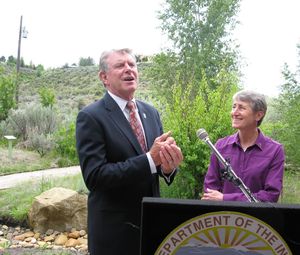Interior Secretary Sally Jewell touts fire strategy aimed at protecting sagebrush ecosysem
U.S. Secretary of Interior Sally Jewell is making her fifth trip to Idaho today, where her visit included joining Gov. Butch Otter, BLM and Forest Service officials to sign a new firefighting strategy for the Great Basin region, including Idaho, Utah, Nevada, Oregon and California, that focuses on protecting the sagebrush steppe ecosystem, home to the potentially endangered sage grouse and an array of other species.
Jewell said, “2015 could be a tough one. We have climate change impacting landscapes across the country. It’s driving some of the drought – you’re seeing that particularly in California, as well as some parts of southern Oregon, as well as some parts here.” She said the key will be how much dry lightning hits. “Last year, Oregon got a boatload of dry lightning and they had a really rough year. We did not have it in some of the other areas. But the reality is we have longer, hotter fire seasons than we ever have before. … We have a need for firefighters for more months of the year, but our budget has not kept up.”
Jewell said the new wildfire strategy makes the sagebrush steppe ecosystem the No. 1 natural resource priority in the Great Basin, while focusing on four points: Working collaboratively to reduce the size, severity and cost of rangeland fires; addressing the spread of invasive species; positioning resources for the most effective response, including pre-staging equipment in line with fire weather forecasts; and as always, focusing on protecting the life and safety of firefighters.
She praised Otter’s work on establishing range fire protection associations in Idaho to allow ranchers to coordinate with wildland firefighters and be first responders to fires on or near their ranching operations, helping stop them when they’re still small. Otter, whom Jewell warmly greeted as an old friend, said, “We now have five organizations that are out there representing 230 ranchers that are our initial attack. Every year, we get a better report about how many fires we were able to hit and stop while they’re small. … It’s been a program that’s already started to pay huge dividends for us.”
Jewell also was joined by Mike Guerry, a rancher and head of the Three Creek Rangeland Fire Protection Association, who said the system is working. “In the beginning, there were some hesitations on both sides,” he said. “That didn’t last very long – probably the first fire.” Jim Hubbard, deputy chief of the Forest Service, said, “If we don’t work together, then we don’t succeed. On this issue, on the sagebrush ecosystem and on the sage grouse, I think we are together.”
Jewell joined the other officials at the Jim Hall Foothills Learning Center in Boise’s foothills for the announcement; birds twittered in the distance and grasses and foliage swayed behind her as the sun moved in and out of the clouds. The center is on the popular Ridge to Rivers trail system, on which Boiseans hike, mountain bike, run, stroll and walk their dogs amid a natural setting that’s right on the edge of neighborhoods. “This is about saving this ecosystem for future generations,” Jewell said. “You all understand here, and from my old day job at REI I certainly understand the economic benefits of having wonderful places like this. … This is what urban areas need to attract the kind of companies that Boise’s been able to attract because you have wonderful landscapes in your backyard.”
She said, “As we look out there and there’s some sagebrush out there, people can look out there and say, ‘There’s nothing there.’ And the reality is, when you talk to the scientists, there is. There are 350 species that depend on that habitat. Game species like mule deer, pronghorn. The greater sage grouse, yes, but also the bald eagle and many other species that call this home. Fire is the No. 1 threat to this ecosystem in the Great Basin states. And as we see the effects of climate change, we see much greater risk to these sagebrush ecosystems.”
AP reporters Keith Ridler and Matthew Volz have a full report here on the secretary’s strategy and how it fits in with the fight to keep the sage grouse from being listed as endangered.

